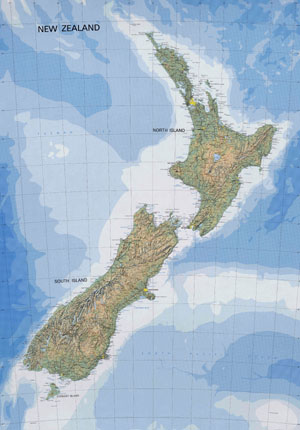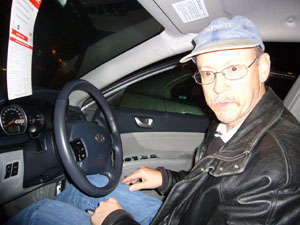So why New Zealand? If youíve seen the Lord of the Rings movies, you might have an inkling. Those expecting to find hobbits will be disappointed, but the scenery is unique, diverse and often spectacular. Maori culture infuses the place, and leads among other things to many place names that are difficult to pronounce. The culture itself is fascinating, and is being kept alive by many Maori practitioners. Driving around the countryside, one is struck by how green everything is, at least in the winter (which August is in the middle of), and various forms of agriculture (especially sheep farming) are seen everywhere. And everyone speaks English.
A little background: New Zealand consists primarily of two large islands, rather unimaginatively named North Island and South Island. It is considered part of Polynesia, and was first populated several centuries ago by Polynesians who canoed there from Polynesian parts unknown and are called Maoris. The first European to visit New Zealand was the Dutch explorer Abel Tasman, who arrived at the west coast in 1642. After Maoris began killing his crewmen, he elected to depart. New Zealand was not revisited by Europeans for more than a century. During this time, New Zealand was thought to be a west-facing coastline of a great southern continent which was felt to extend as far east as the tip of South America. This idea was dispelled by the next European explorer to reach the area, James Cook, who arrived in his ship Endeavour and mapped the islands in some detail in 1769. Many of the non-Maori place names in New Zealand were established by Cook. Cookís encounters with the Maori people were for the most part more successful than Tasmanís, and shortly after Cookís voyage, Europeans began trading with the Maoris. Missionaries and others began settling New Zealand in the early 19th Century; there were a number of disputes with the indigenous population (including Land Wars in the 1860ís and 1870ís) which were settled, but not always to the complete satisfaction of the Maoris, many of whom remain less than delighted to the current day. New Zealand is now a constitutional monarchy (Elizabeth II is the Queen) with a parliamentary democracy, and its capital is Wellington (named for the British victor at Waterloo), located at the south end of North Island. Its largest city is Auckland (in the northern part of North Island, named for the Earl of Auckland), which claims about 1.3 million of New Zealandís 4.3 million residents. Despite the countryís smallish population, New Zealand fields a world class rugby team, the All Blacks (named for their uniforms), and many New Zealanders (including especially the Maoris) are fanatical about the game.
Another interesting fact about New Zealand is that itís very far from Los Angeles - our flight over that distance lasted 13 hours. As the flight actually travels a little farther south than it does west, in addition to jet lag, a traveler has to deal with "climate lag". The middle of summer in Los Angeles is the middle of winter in New Zealand, and our arrival in Auckland at 5 AM the morning of August 5 was dark, rainy and cold (probably the mid-40ís F.). We got through Immigration, baggage claim and Customs without incident (apparently "kia ora" means "welcome" in Maori), and were able to find an ATM and our rental car (a Hyundai from Avis) without difficulty.
It quickly becomes obvious to even the most unobservant driver that in New Zealand, steering wheels are on the right of the car and driving is on the left of the road, but just to make sure, Avis affixes "Keep Left" stickers to their speedometers. It actually isnít that difficult to get it mostly right, but it adds a certain amount of tension to the driving experience if one isnít used to it. The trickiest things are the turns, when you have to remember to turn into the correct lane (i.e. the one on the left). It also takes some practice to stop getting into the car on the left side and being surprised by the absence of a steering wheel. Distances and speed limits are metric, but this isnít difficult to get used to either Ė you just have to remember that kilometers elapse somewhat faster than miles (about 1.6 times faster), and that if the round speed limit signs say 80 but the number on your speedometer says 100, youíre going too fast. With all this in mind, we left the airport and headed in the general direction of our first destination, the town of Rotorua.

